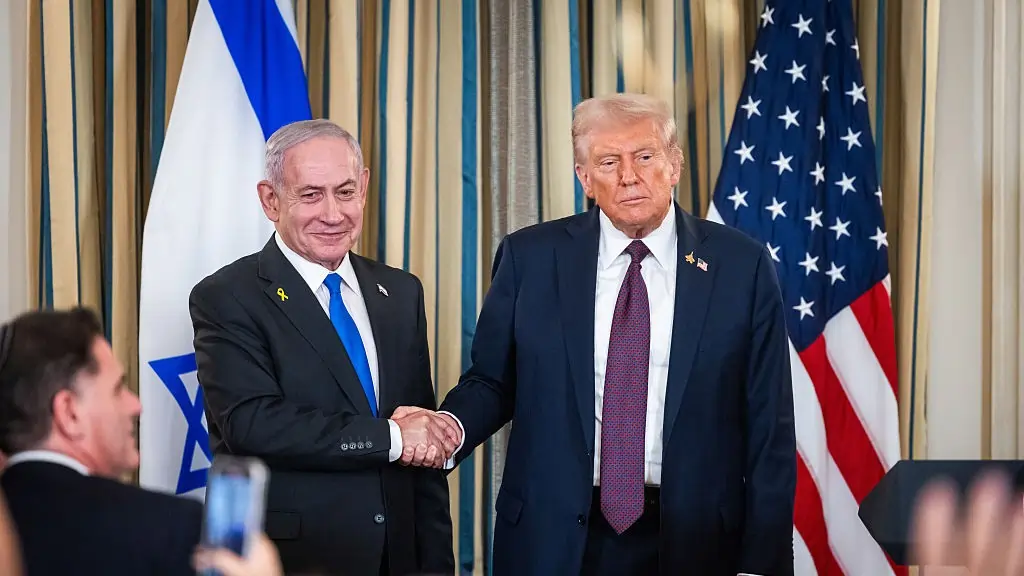New Delhi: The United States has introduced a comprehensive 20-point peace plan to bring an immediate end to the Israel-Gaza war, a conflict that has claimed over 66,000 Palestinian lives and left Gaza in ruins after more than two years of escalation. Unveiled by President Donald Trump on September 29, 2025, during a White House meeting with Israeli Prime Minister Benjamin Netanyahu, the proposal has been accepted by Israel and welcomed by global leaders, including Indian Prime Minister Narendra Modi. While Hamas has yet to formally respond, the plan offers a structured pathway to cease hostilities, release hostages, and rebuild Gaza under a new governance model.

Historical Context: A Century of Conflict
The Israel-Gaza conflict is rooted in over a century of tensions, beginning with the Balfour Declaration of 1917, when Britain endorsed the establishment of a Jewish national home in Palestine. At the time, Jews were a minority in a predominantly Arab region, setting the stage for escalating disputes. In 1947, the United Nations proposed partitioning Palestine into separate Arab and Jewish states, a plan rejected by Arab leaders. The subsequent declaration of Israel’s independence in 1948 triggered multiple wars.
The 1967 Middle East War marked a turning point, placing approximately one million Palestinians in the West Bank, Gaza, and East Jerusalem under Israeli control. The 1973 Yom Kippur War, also known as the Ramadan War, led to the Camp David Accords in 1978, the first instance of an Arab nation—Egypt—recognizing Israel. In 1979, Israel returned the Sinai Peninsula to Egypt but retained control over the West Bank. The current conflict, intensified by Hamas’ Operation Al-Aqsa Storm over two years ago, has deepened the humanitarian crisis in Gaza, necessitating urgent diplomatic intervention.
The White House Proposal: A 20-Point Framework
Announced on September 29, 2025, the White House’s 20-point plan aims to halt the war immediately if accepted by both Israel and Hamas. Netanyahu has endorsed the proposal, while Hamas official Mahmoud Mardawi told Al Jazeera that the group has not yet received a written version. The plan focuses on deradicalization, reconstruction, and demilitarization, ensuring Gaza becomes a terror-free zone that poses no threat to its neighbors. It also prioritizes humanitarian aid, hostage releases, and a transitional governance system. Below is the full text of the proposal:
- Gaza will be a deradicalised terror-free zone that does not pose a threat to its neighbours.
- Gaza will be redeveloped for the benefit of the people of Gaza, who have suffered more than enough.
- If both sides agree to this proposal, the war will immediately end. Israeli forces will withdraw to the agreed-upon line to prepare for a hostage release. During this time, all military operations, including aerial and artillery bombardment, will be suspended, and battle lines will remain frozen until conditions are met for the complete staged withdrawal.
- Within 72 hours of Israel publicly accepting this agreement, all hostages, alive and deceased, will be returned.
- Once all hostages are released, Israel will release 250 life-sentence prisoners, plus 1,700 Gazans who were detained after October 7th 2023, including all women and children detained in that context. For every Israeli hostage whose remains are released, Israel will release the remains of 15 deceased Gazans.
- Once all hostages are returned, Hamas members who commit to peaceful co-existence and to decommission their weapons will be given amnesty. Members of Hamas who wish to leave Gaza will be provided safe passage to receiving countries.
- Upon acceptance of this agreement, full aid will be immediately sent into the Gaza Strip. At a minimum, aid quantities will be consistent with what was included in the January 19, 2025, agreement regarding humanitarian aid, including rehabilitation of infrastructure (water, electricity, sewage), rehabilitation of hospitals and bakeries, and entry of necessary equipment to remove rubble and open roads.
- Entry of distribution and aid in the Gaza Strip will proceed without interference from the two parties through the United Nations and its agencies, and the Red Crescent, in addition to other international institutions not associated in any manner with either party. Opening the Rafah crossing in both directions will be subject to the same mechanism implemented under the January 19, 2025, agreement.
- Gaza will be governed under the temporary transitional governance of a technocratic, apolitical Palestinian committee, responsible for delivering the day-to-day running of public services and municipalities for the people in Gaza. This committee will be made up of qualified Palestinians and international experts, with oversight and supervision by a new international transitional body, the “Board of Peace,” which will be headed and chaired by President Donald J Trump, with other members and heads of State to be announced, including Former Prime Minister Tony Blair. This body will set the framework and handle the funding for the redevelopment of Gaza until such time as the Palestinian Authority has completed its reform program, as outlined in various proposals, including President Trump’s peace plan in 2020 and the Saudi-French proposal, and can securely and effectively take back control of Gaza. This body will call on best international standards to create modern and efficient governance that serves the people of Gaza and is conducive to attracting investment.
- A Trump economic development plan to rebuild and energise Gaza will be created by convening a panel of experts who have helped birth some of the thriving modern miracle cities in the Middle East. Many thoughtful investment proposals and exciting development ideas have been crafted by well-meaning international groups, and will be considered to synthesise the security and governance frameworks to attract and facilitate these investments that will create jobs, opportunity, and hope for future Gaza.
- A special economic zone will be established, with preferred tariff and access rates to be negotiated with participating countries.
- No one will be forced to leave Gaza, and those who wish to leave will be free to do so and free to return. We will encourage people to stay and offer them the opportunity to build a better Gaza.
- Hamas and other factions agree to not have any role in the governance of Gaza, directly, indirectly, or in any form. All military, terror, and offensive infrastructure, including tunnels and weapon production facilities, will be destroyed and not rebuilt. There will be a process of demilitarisation of Gaza under the supervision of independent monitors, which will include placing weapons permanently beyond use through an agreed process of decommissioning, and supported by an internationally funded buy-back and reintegration program all verified by the independent monitors. New Gaza will be fully committed to building a prosperous economy and to peaceful coexistence with their neighbours.
- A guarantee will be provided by regional partners to ensure that Hamas, and the factions, comply with their obligations and that New Gaza poses no threat to its neighbours or its people.
- The United States will work with Arab and international partners to develop a temporary International Stabilization Force (ISF) to immediately deploy in Gaza. The ISF will train and provide support to vetted Palestinian police forces in Gaza, and will consult with Jordan and Egypt who have extensive experience in this field. This force will be the long-term internal security solution. The ISF will work with Israel and Egypt to help secure border areas, along with newly trained Palestinian police forces. It is critical to prevent munitions from entering Gaza and to facilitate the rapid and secure flow of goods to rebuild and revitalise Gaza. A deconfliction mechanism will be agreed upon by the parties.
- Israel will not occupy or annex Gaza. As the ISF establishes control and stability, the Israel Defence Forces (IDF) will withdraw based on standards, milestones, and timeframes linked to demilitarisation that will be agreed upon between the IDF, ISF, the guarantors, and the United States, with the objective of a secure Gaza that no longer poses a threat to Israel, Egypt, or its citizens. Practically, the IDF will progressively hand over the Gaza territory it occupies to the ISF, according to an agreement they will make with the transitional authority, until they are withdrawn completely from Gaza, save for a security perimeter presence that will remain until Gaza is properly secure from any resurgent terror threat.
- In the event Hamas delays or rejects this proposal, the above, including the scaled-up aid operation, will proceed in the terror-free areas handed over from the IDF to the ISF.
- An interfaith dialogue process will be established based on the values of tolerance and peaceful co-existence to try and change mindsets and narratives of Palestinians and Israelis by emphasising the benefits that can be derived from peace.
- While Gaza re-development advances and when the PA reform program is faithfully carried out, the conditions may finally be in place for a credible pathway to Palestinian self-determination and statehood, which we recognise as the aspiration of the Palestinian people.
- The United States will establish a dialogue between Israel and the Palestinians to agree on a political horizon for peaceful and prosperous co-existence.
International Reactions and Support
The proposal has received significant international attention. On September 30, 2025, Indian Prime Minister Narendra Modi welcomed the plan, describing it as a “comprehensive” initiative that provides a “viable pathway to long-term and sustainable peace, security, and development” for Palestinians, Israelis, and the broader West Asian region. Modi urged all parties to support Trump’s effort, a statement shared on X in Hebrew, English, Arabic, and Chinese.
Israeli Ambassador to India Reuven Azar responded by highlighting opportunities for India in Gaza’s reconstruction, noting potential projects worth “dozens of billions of dollars.” He emphasized India’s capacity to contribute, aligning with its consistent advocacy for a two-state solution, as reiterated by India’s Ministry of External Affairs since October 7, 2023. However, the ministry has not yet clarified how India’s two-state policy aligns with the proposed “Board of Peace” governance model.
Leaders across the Middle East and Europe have also expressed support, though some note fundamental obstacles. Trump framed the plan as part of a broader vision for Middle East peace during his meeting with Netanyahu, a sentiment echoed in related diplomatic developments, such as Qatar’s involvement in a U.S.-Israel trilateral mechanism.
Implementation Challenges and Future Prospects
While the plan outlines a clear roadmap, challenges persist. Hamas’ lack of an official response raises concerns, as does the feasibility of enforcing demilitarization and ensuring regional guarantees. The provision to proceed with aid and reconstruction in “terror-free areas” if Hamas delays or rejects the plan offers flexibility but complicates full implementation.
The proposal’s emphasis on a technocratic Palestinian committee, supervised by the Trump-led “Board of Peace,” introduces a novel governance model. The inclusion of figures like former UK Prime Minister Tony Blair and the focus on economic revitalization through a special economic zone signal a commitment to long-term stability. The interfaith dialogue process and pathway to Palestinian self-determination further underscore the plan’s ambition to address both immediate and systemic issues.
As the international community awaits Hamas’ response, the plan represents a significant diplomatic effort to end a devastating conflict. Its success will depend on cooperation from all parties, robust regional support, and the effective execution of its multifaceted components.
FAQs
1. What is the goal of Trump’s 20-point Gaza peace plan?
The plan, unveiled by U.S. President Donald Trump on September 29, 2025, aims to immediately end the Israel-Gaza war, which has killed over 66,000 Palestinians and devastated Gaza. It seeks to create a deradicalized, terror-free Gaza, facilitate hostage releases, deliver humanitarian aid, and establish a transitional governance system to rebuild the region and promote long-term peace.
2. What are the key components of the peace proposal?
The 20-point plan includes an immediate ceasefire, the release of all hostages within 72 hours, the release of 1,950 Palestinian prisoners, and amnesty for Hamas members committing to peace. It proposes a technocratic Palestinian committee under a “Board of Peace” chaired by Trump, a special economic zone, demilitarization of Gaza, and the deployment of an International Stabilization Force (ISF) to ensure security.
3. Has the plan been accepted by all parties involved?
Israeli Prime Minister Benjamin Netanyahu has accepted the proposal, as announced during his White House visit on September 29, 2025. However, Hamas has not yet provided an official response, with official Mahmoud Mardawi stating the group has not received a written version of the plan.
4. How will Gaza be governed under this plan?
Gaza will be temporarily governed by an apolitical, technocratic Palestinian committee responsible for public services, overseen by an international “Board of Peace” chaired by President Trump and including figures like former UK Prime Minister Tony Blair. This body will manage Gaza’s redevelopment until the Palestinian Authority completes its reform program and can resume control.
5. What international support has the plan received?
Indian Prime Minister Narendra Modi welcomed the plan on September 30, 2025, calling it a “viable pathway to long-term peace.” Israeli Ambassador Reuven Azar noted opportunities for India in Gaza’s reconstruction. Leaders in the Middle East and Europe have also expressed support, though challenges remain, including Hamas’ response and implementation hurdles

